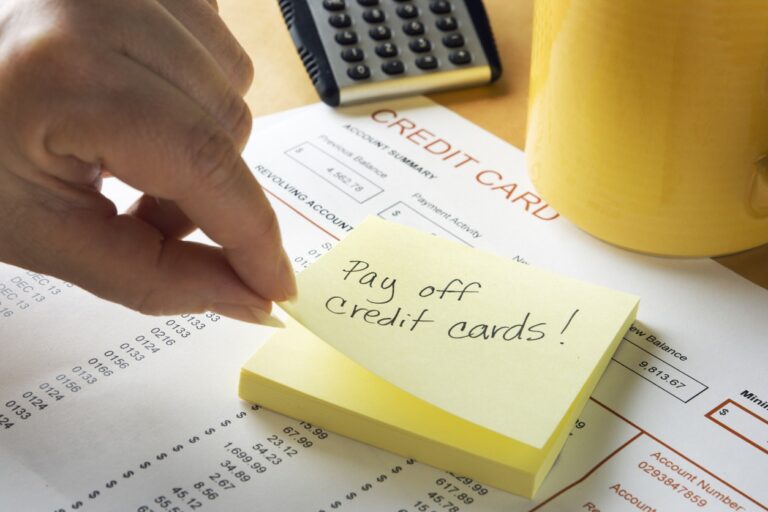On this page
What's next
Earn a high-yield savings rate with JG Wentworth Debt Relief
How to Break the Credit Card Debt Cycle
by
JG Wentworth
•
August 6, 2025
•
8 min

Credit card debt can feel like quicksand—the more you struggle, the deeper you sink. According to TransUnion, one of the three biggest credit reporting agencies in the U.S., the average credit card debt per American in May 2025 was $6,434. That’s up from $6,269 from May 2024, a $164 increase.
So, if you’re struggling to keep up with your payments, you are far from alone: millions of people find themselves trapped in a seemingly endless cycle of minimum payments, accumulating interest, and financial stress. Breaking free from this cycle requires more than just willpower; it demands a strategic approach, disciplined execution, and often a fundamental shift in how you think about money.*
The credit card debt trap
Before you can escape the debt cycle, it’s crucial to understand exactly how it works. Credit card companies profit from customers who carry balances month to month, paying only the minimum required amount. Here’s why this system is so insidious:
- When you make only minimum payments—typically 2-3% of your outstanding balance—the vast majority of your payment goes toward interest rather than principal. For example, if you owe $5,000 at 18% APR and make only minimum payments of $100, it would take you over 7 years to pay off the debt, and you’d pay more than $3,000 in interest alone.
- The psychological aspect is equally damaging. As balances remain high despite regular payments, many people become discouraged and either give up entirely or, worse, continue using their cards for new purchases. This creates a vicious cycle where debt grows faster than payments can reduce it.
Step 1: Stop the bleeding
The first and most critical step in breaking the debt cycle is to stop adding new debt. This means putting your credit cards away—literally. Consider these strategies:
- Freeze your cards: Place your credit cards in a block of ice in your freezer. This creates a physical and temporal barrier to impulsive purchases while keeping the cards available for true emergencies.
- Remove cards from digital wallets: Delete stored payment information from online retailers, apps, and digital wallets. The friction of having to manually enter card information can prevent impulse purchases.
- Switch to cash or debit: For everyday expenses, use cash or a debit card tied to a checking account with limited funds. This forces you to spend only what you actually have.
- Create accountability: Tell trusted friends or family members about your commitment to stop using credit cards. External accountability can provide additional motivation when temptation strikes.
Step 2: Create a complete financial picture
You can’t manage what you don’t measure. Gather all your credit card statements and create a comprehensive debt inventory. For each card, record:
- Current balance
- Minimum monthly payment
- Interest rate (APR)
- Available credit limit
- Payment due date
Next, calculate your total monthly debt service (the sum of all minimum payments) and compare it to your monthly income. If this ratio exceeds 20%, you’re in what financial experts consider dangerous territory.
Create a detailed budget that accounts for all income and expenses. Use the 50/30/20 rule as a starting framework:
- 50% for needs (housing, utilities, groceries)
- 30% for wants (entertainment, dining out)
- 20% for debt repayment and savings
However, if you’re in significant debt, you may need to temporarily adjust this to 50/10/40, dramatically reducing discretionary spending to accelerate debt payoff.
Step 3: Choose your debt elimination strategy
Two primary strategies dominate debt elimination discussions, each with distinct psychological and mathematical advantages:
- The Debt Avalanche Method focuses on mathematical optimization. List all debts by interest rate, from highest to lowest. Make minimum payments on all debts while directing any extra money toward the highest-rate debt. Once that’s eliminated, move to the next highest rate. This method minimizes total interest paid over time.
- The Debt Snowball Method prioritizes psychological momentum. List debts from smallest balance to largest, regardless of interest rate. Focus extra payments on the smallest debt first. The quick wins from eliminating smaller balances can provide emotional fuel to tackle larger debts.
Research suggests that while the avalanche method is mathematically superior, the snowball method often proves more effective in practice because it provides regular psychological victories that sustain motivation. Choose the method that best fits your personality and situation.
Take your next step towards being debt-free
"*" indicates required fields
Step 4: Find extra money for debt payments
Breaking the debt cycle requires paying more than minimums, which means finding additional money in your budget. Consider these approaches:
- Increase income: Take on freelance work, sell unused possessions, or pursue a temporary side hustle. Even an extra $200 per month can dramatically reduce payoff time. For example, adding $200 to a $5,000 balance at 18% APR reduces payoff time from 7 years to under 2 years.
- Reduce expenses: Audit your spending ruthlessly. Cancel unused subscriptions, negotiate lower rates for utilities and insurance, cook more meals at home, and find free entertainment alternatives. Small changes compound quickly.
- Use windfalls strategically: Direct tax refunds, bonuses, gifts, or unexpected income directly toward debt rather than lifestyle inflation. These lump sums can provide significant momentum.
Step 5: Consider debt consolidation options
Consolidation can simplify payments and potentially reduce interest rates, but it’s not a magic solution. Evaluate these options carefully:
- Balance transfer cards offer promotional 0% APR periods, typically 12-21 months. This can provide breathing room to pay down principal without accumulating interest. However, balance transfer fees (usually 3-5%) and the risk of reverting to high rates make this strategy suitable only for those with disciplined payoff plans.
- Personal loans often offer lower interest rates than credit cards and fixed payment schedules that ensure eventual payoff. Shop around with banks, credit unions, and online lenders to find the best rates.
- Home equity loans typically offer the lowest interest rates but put your home at risk. Use this option only if you’re absolutely committed to not accumulating new credit card debt.
- Debt management plans through nonprofit credit counseling agencies can negotiate lower interest rates and consolidated payments with creditors. These programs typically take 3-5 years but can significantly reduce total payments.
Step 6: Build systems to prevent relapse
Breaking the debt cycle once isn’t enough—you must build systems to prevent falling back into old patterns:
- Emergency fund priority: Even while paying off debt, try to accumulate a small emergency fund of $500-$1,000. This prevents new debt when unexpected expenses arise. Once debt is eliminated, build this to 3-6 months of expenses.
- Automate everything: Set up automatic payments for all bills and debt payments immediately after payday. This removes the temptation to spend money earmarked for debt elimination.
- Regular financial check-ins: Schedule monthly money meetings with yourself (or your partner) to review progress, adjust budgets, and celebrate milestones. This maintains awareness and prevents backsliding.
- Identify and address triggers: Understand what circumstances lead to overspending. Common triggers include stress, social situations, boredom, or specific emotions. Develop alternative coping strategies that don’t involve spending.
Step 7: Address the psychological aspects
Credit card debt often has deep psychological roots that must be addressed for lasting change:
- Understand your money story: Examine beliefs about money formed in childhood. Do you view credit as “free money”? Do you use spending to cope with emotions? Identifying these patterns is the first step to changing them.
- Practice delayed gratification: Before any non-essential purchase, implement a waiting period—24 hours for purchases under $100, a week for larger amounts. Often, the desire will pass.
- Find non-financial sources of reward: Many people use shopping as entertainment or emotional regulation. Develop alternatives like exercise, hobbies, social activities, or creative pursuits that provide similar psychological benefits without financial cost.
- Celebrate progress: Acknowledge milestones in your debt elimination journey. When you pay off a card or reach a balance milestone, celebrate in ways that don’t involve spending money. This reinforces positive financial behaviors.
The bottom line
Breaking the credit card debt cycle requires commitment, strategy, and often fundamental changes in how you relate to money. The journey isn’t always easy, but the psychological and financial freedom that comes from eliminating high-interest debt makes every sacrifice worthwhile.
Remember that progress, not perfection, is the goal. Small, consistent actions compound over time into significant results. Each payment brings you closer to financial freedom, and each month without new debt strengthens your new financial habits.
The credit card companies that once profited from your debt payments will no longer have that power over your financial future. Instead, you’ll join the ranks of people who use credit cards as tools for convenience and rewards, paying them off in full each month and building wealth rather than paying interest.
There’s always JG Wentworth…
Struggling with unsecured debt such as credit card payments? We might be able to help. If you owe $10,000 or more there’s a good chance you’ll qualify for the JG Wentworth Debt Relief Program.* Some of our program perks include:
- One monthly program payment
- We negotiate on your behalf
- Average debt resolution in as little as 24-60 months
- We only get paid when we settle your debt
If you think you qualify for our program, give us a call today so we can go over the best options for your specific financial needs. Why go it alone when you can have a dedicated team on your side?
* This information is provided for educational and informational purposes only. Such information or materials do not constitute and are not intended to provide legal, accounting, or tax advice and should not be relied on in that respect. We suggest that You consult an attorney, accountant, and/or financial advisor to answer any financial or legal questions.
About the author
Recommended reading for you
* Program length varies depending on individual situation. Programs are between 24 and 60 months in length. Clients who are able to stay with the program and get all their debt settled realize approximate savings of 43% before our 25% program fee. This is a Debt resolution program provided by JGW Debt Settlement, LLC (“JGW” of “Us”)). JGW offers this program in the following states: AL, AK, AZ, AR, CA, CO, FL, ID, IN, IA, KY, LA, MD, MA, MI, MS, MO, MT, NE, NM, NV, NY, NC, OK, PA, SD, TN, TX, UT, VA, DC, and WI. If a consumer residing in CT, GA, HI, IL, KS, ME, NH, NJ, OH, RI, SC and VT contacts Us we may connect them with a law firm that provides debt resolution services in their state. JGW is licensed/registered to provide debt resolution services in states where licensing/registration is required.
Debt resolution program results will vary by individual situation. As such, debt resolution services are not appropriate for everyone. Not all debts are eligible for enrollment. Not all individuals who enroll complete our program for various reasons, including their ability to save sufficient funds. Savings resulting from successful negotiations may result in tax consequences, please consult with a tax professional regarding these consequences. The use of the debt settlement services and the failure to make payments to creditors: (1) Will likely adversely affect your creditworthiness (credit rating/credit score) and make it harder to obtain credit; (2) May result in your being subject to collections or being sued by creditors or debt collectors; and (3) May increase the amount of money you owe due to the accrual of fees and interest by creditors or debt collectors. Failure to pay your monthly bills in a timely manner will result in increased balances and will harm your credit rating. Not all creditors will agree to reduce principal balance, and they may pursue collection, including lawsuits. JGW’s fees are calculated based on a percentage of the debt enrolled in the program. Read and understand the program agreement prior to enrollment.
This information is provided for educational and informational purposes only. Such information or materials do not constitute and are not intended to provide legal, accounting, or tax advice and should not be relied on in that respect. We suggest that you consult an attorney, accountant, and/or financial advisor to answer any financial or legal questions.






